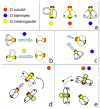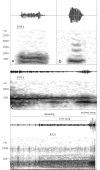Substrate vibrations during courtship in three Drosophila species
- PMID: 24260459
- PMCID: PMC3829934
- DOI: 10.1371/journal.pone.0080708
Substrate vibrations during courtship in three Drosophila species
Abstract
While a plethora of studies have focused on the role of visual, chemical and near-field airborne signals in courtship of Drosophila fruit flies, the existence of substrate-borne vibrational signals has been almost completely overlooked. Here we describe substrate vibrations generated during courtship in three species of the D. melanogaster group, from the allegedly mute species D. suzukii, its sister species D. biarmipes, and from D. melanogaster. In all species, we recorded several types of substrate vibrations which were generated by locomotion, abdominal vibrations and most likely through the activity of thoracic wing muscles. In D. melanogaster and D. suzukii, all substrate vibrations described in intact males were also recorded in males with amputated wings. Evidence suggests that vibrational signalling may be widespread among Drosophila species, and fruit flies may provide an ideal model to study various aspects of this widespread form of animal communication.
Conflict of interest statement
Figures



References
-
- Markow TA, O’Grady PM (2005) Evolutionary genetics of reproductive behavior in Drosophila: connecting the dots. Annu Rev Genet 39: 363-291. - PubMed
Publication types
MeSH terms
LinkOut - more resources
Full Text Sources
Other Literature Sources
Molecular Biology Databases

